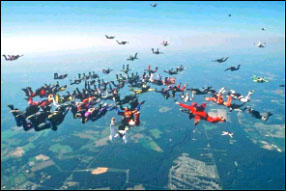Parachuting
This task is about retrieving information and making inferences from a text.
Read the article below and answer the questions that follow.
|
Parachuting
Parachuting involves a wide variety of sports and techniques, from free falling to paragliding. Leonardo da Vinci has been recognised as having invented the principle of the parachute; however it was only in 1797 when the Frenchman Andre Jacques Garnerin applied it by letting himself fall from a balloon with an open parachute equipped with a basket.Parachuting was first used for military purposes, (as a rescue method during World War One and a tool for invasion during the Second World War).The first world championships, involving accuracy landing, took place in 1951. The world championship of formation skydiving was held in 1975, followed in 1986 by the world championship of canopy formation. The World Air Games, first held in 1997, had competitions in freestyle and skysurfing.
Accuracy Landing competition
This event is open to men and women, and has individual and team competitions. The jumps are made from 1000 m. The competitors must land with their toe or heel on a yellow dead-centre disk 3 cm in diameter, or as near to it as possible. The disk is placed in the centre of a square. The order of the jumps is determined by a random draw. In the team event, the 4 teammates jump together and open their parachutes at different altitudes so that they succeed each other in landing on the target at regular intervals (20 to 30 seconds).
Free fall style
Jumping from 2200 m, the parachutist must perform a series of 6 required actions during their free fall in a minimum amount of time. The figures are turns to the right and left and somersaults. Execution faults are penalised by the addition of seconds or fractions of seconds to the total time.
Formation skydiving
Teams of 4, 8, or 16 parachutists in free fall perform a series of required figures. They repeat the series as many times as possible in the time allowed (35 seconds for teams of 4, 50 seconds for teams of 8). Jumps start at 3000 m and 3800 m, respectively.
|
Source: Free Fall, Written/edited by Kathy Basalaj.Applications, Learning Media, Wellington, 1994. (Text altered/abridged). © Crown Copyright.
a) What were the two ways that the military used parachuting during warfare?
|
1.
|
|
| 2. |
|
b) Use the information from the article to complete the table.
Parachute competition
| Type of competition | Height of jumps | What you have to do? | Time it takes |
| Accuracy landing | |||
| Free fall style | No answer required. | ||
| 4-way formation skydiving |
A reason for this is:
|
c)
|
Use what you wrote in the the table above to answer the following questions:
|
|
|
|
The event most likely to be judged most accurately would be
|
|
|
|
A reason for this is:
|
|
|
|
The event that would put the most demands on judges to make fast decisions would be
|
|
|
|
|
|
d) Read about the following flying positions and answer the questions that follow.
| A. The basic position: the skydiver "rests" on the wind. |
 |
| B. To fall faster: the skydiver arches up, lifting his/her arms back and legs higher so less body surface is presented to the air. |
 |
| C. To glide or track: the skydiver angles his/her body to the relative wind (the air coming from below). |
 |
| D. A steeper glide is a dive. |
 |
| E. To slow down, the skydiver needs to "catch" the air flowing past his/her body. Straightens out the legs and drop arms. |
 |
e) Use the pictures in the table to answer the following questions.

| i) | If the parachutist had to reach the formation quickly and directly from above, what position(s) should be adopted? |
(Circle your answer/s)
| A | B | C | D | E |
| ii) | If the parachutist overshot and got below the formation what position should one adopt to try and re-join the formation? |
(Circle your answer/s)
| A | B | C | D | E |

